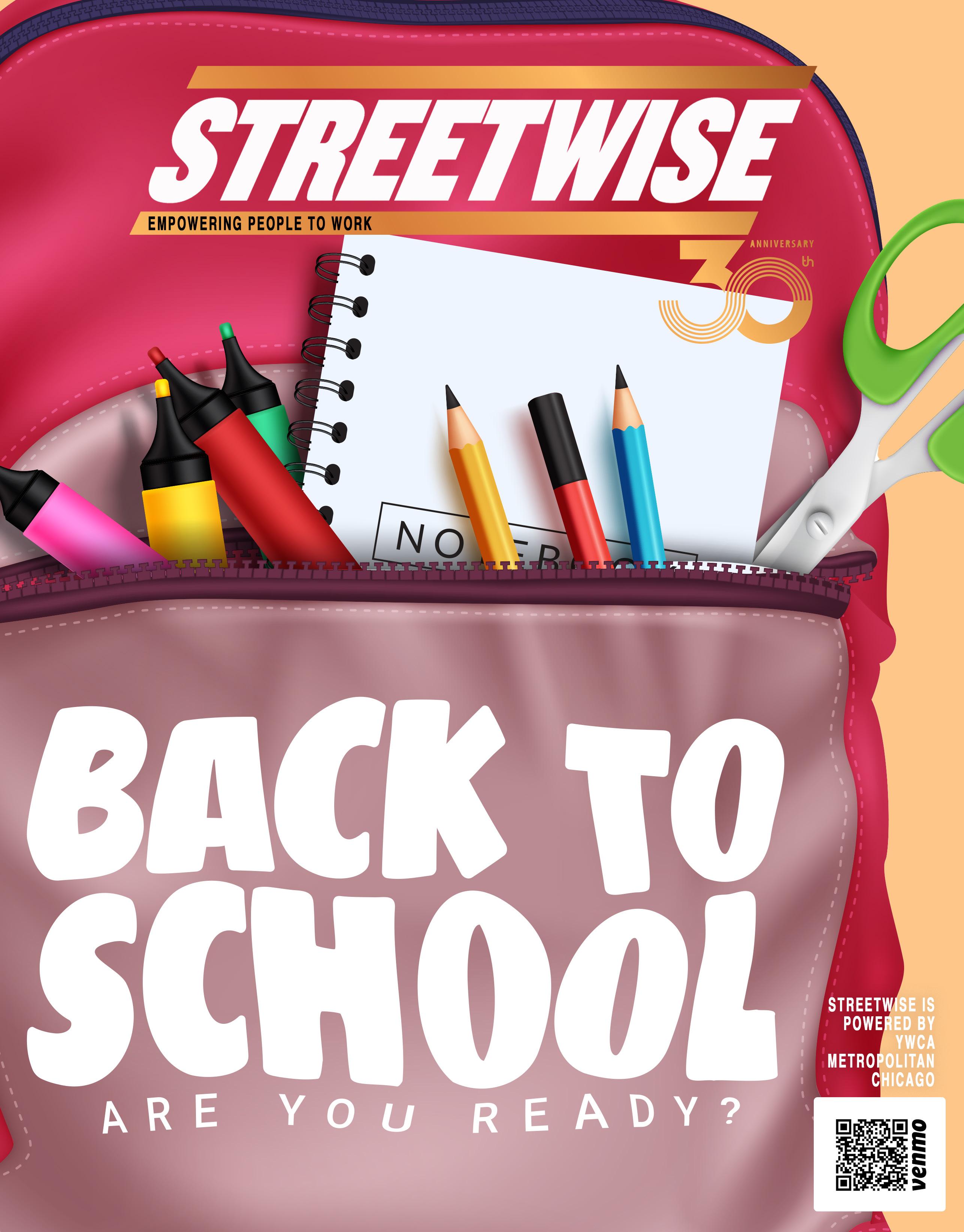
August 30 - September 5, 2023 Vol. 31 No. 35 $1.85 + Tips go to your Vendor $3
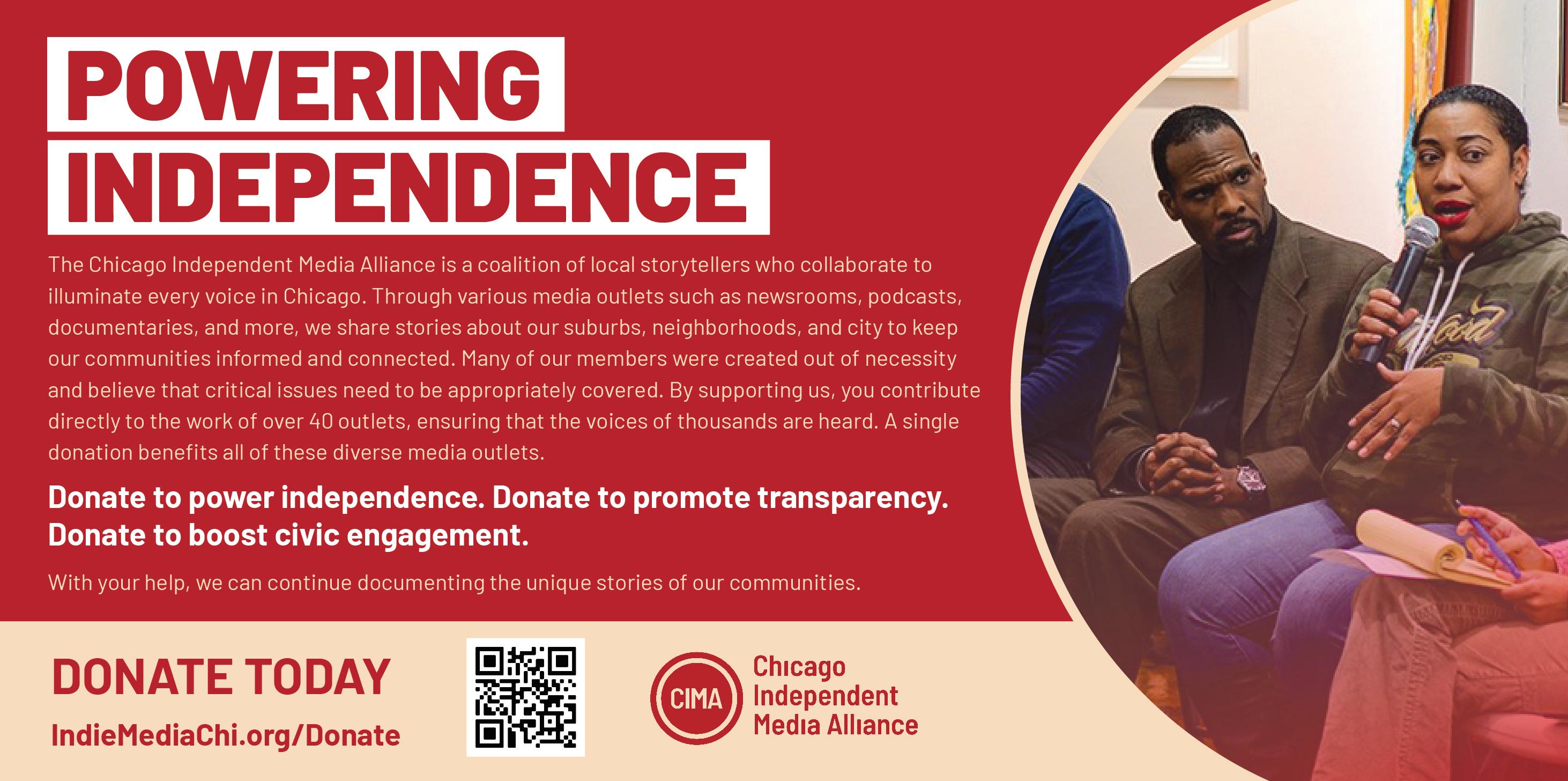

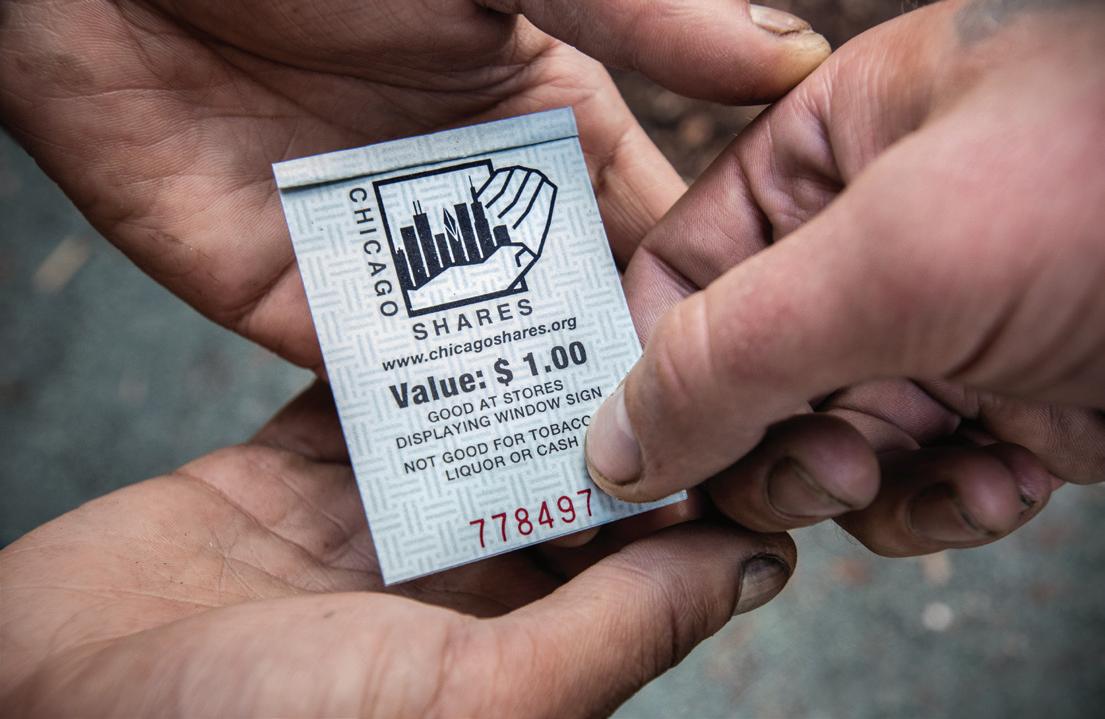
ADVERTISEMENT
4 6 7 8 12 15

Arts & Entertainment
Event highlights of the week!



SportsWise
The SportsWise team discusses the USA's Women's World Cup defeat.
Voice of the Streets Op-ed

For Labor Day 2023, Illinois State University labor history and management expert Dr. Victor Devinatz discusses the effect of the COVID-19 pandemic and a productive path for labor advocates regarding society as a whole.
Cover Story: Back to school
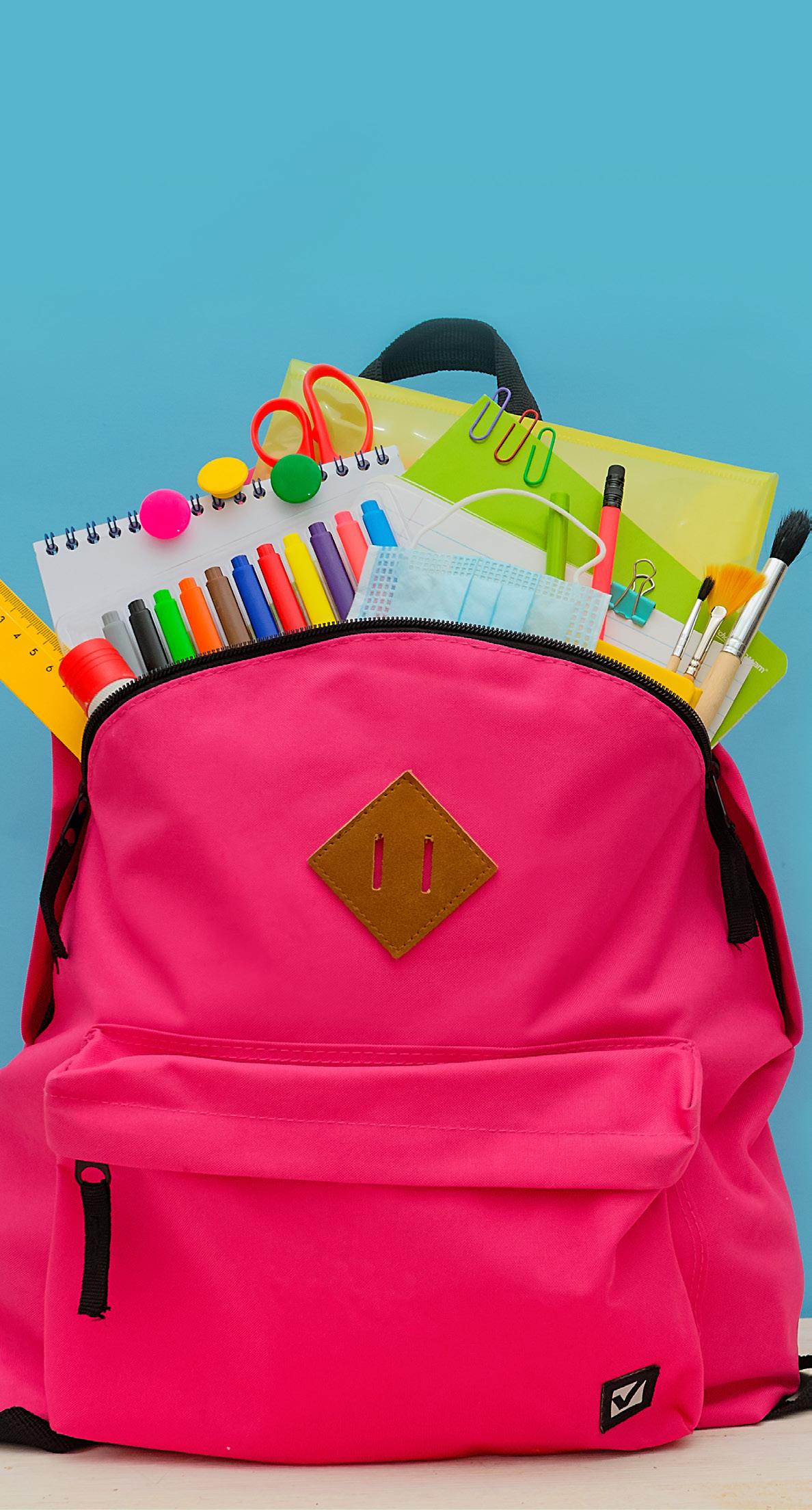
The start of the school year is a fresh start for everyone, not just families with children. Women – and moms in particular – take on more activities that mean less sleep and potentially also Seasonal Affective Disorder. A regular routine helps kids stay grounded and enough sleep helps teens – even in lowincome schools – do better, as Seattle schools learned several years ago.
From the Streets
St. Basil Greek Orthodox Church celebrates its centennial September 17. The church at Ashland Avenue and Polk Street was founded by immigrants from Crete 100 years ago. One of its treasures is a Nativity icon painted in mid-15th century style.
The Chicago Coalition of the Homeless announces six new college scholarship winners.
The Playground
DISCLAIMER:
Dave Hamilton, Creative Director/Publisher dhamilton@streetwise.org
Suzanne Hanney, Editor-In-Chief suzannestreetwise@yahoo.com
Amanda Jones, Director of programs ajones@streetwise.org
Julie Youngquist, Executive director jyoungquist@streetwise.org
Ph: 773-334-6600
Office: 2009 S. State St., Chicago, IL, 60616
make a donation to StreetWise, visit our website at www.streetwise.org/donate/ or cut out this form and mail it with your donation to StreetWise, Inc., 2009 S. State St., Chicago, IL 60616.
appreciate your support!
donation is for the amount of $________________________________Billing Information: Check #_________________Credit Card Type:______________________Name:_______
accept: Visa, Mastercard, Discover or American Express Address:_____ Account#:_____________________________________________________City:___________________________________State:_________________Zip:_______________________ Expiration Date:________________________________________________Phone #:_________________________________Email: StreetWiseChicago @StreetWise_CHI
MORE AT streetwise.org
DONATE To
We
My
We
LEARN
The views, opinions, positions or strategies expressed by the authors and those providing comments are theirs alone, and do not necessarily reflect the views, opinions, or positions of StreetWise.
ARTS & ENTERTAINMENT RECOMMENDATIONS

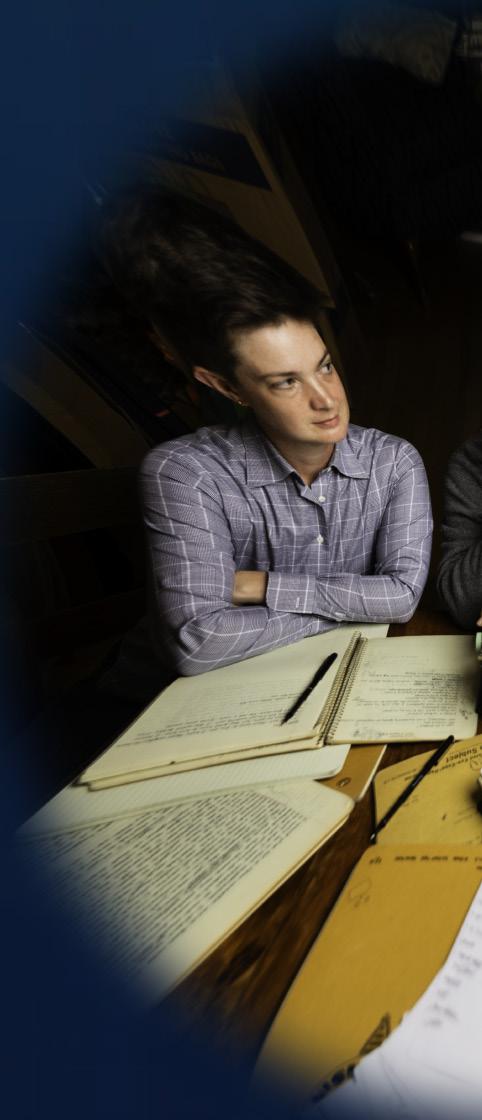
A Festival for the Soul!
34th Annual African Festival of the Arts

Africa International House USA, Inc., presents the 34th Annual African Festival Of The Arts September 1-4, in Washington Park, 5100 S. Cottage Grove Ave. This traditional, end-of-summer, culturally immersive and interactive event brings the art, sights, tastes, sounds, and spirituality of African Diaspora cultures to Chicago – in a replicated African village! Non-stop entertainment representing the full arc of global Black music expression is featured on two stages.
The festival’s gated grounds are a safe zone for children, who can watch the towering S.P.I.R.I.T. Stilt Walkers or engage in activities from computer coding to arts and crafts with the Betty Shabazz Academy. New and experienced musicians are invited to the Drum Circle, where hypnotic rhythms will revitalize you and inspire the dancer in you! Discover natural healing practices and learn from the masters in the Spiritual, Health and Wellness Pavilions in the Ancestral Grove that features interactive activities including cycling, yoga, meditation and Zumba dancing! Tickets start at $30 at aihusa.org
What Lies Beneath!
‘Moon at the Bottom of the Ocean”
Curious Theatre Branch presents the first production in its 35th season, the world premiere of "Moon at the Bottom of the Ocean." Who is mooning at the bottom of the ocean? How did the moon even get down there? Writer Paul loves singer Leslie. They’ve been married, let’s say, a while now. But Paul is stuck. He can’t write, and the mediocre hack at the corner coffee shop is getting all the accolades. W hat’s a chump to do? Hire a P.I., obviously, to discover the secret of literary success. Will Paul learn the deep-down mysteries, or find himself washed up? Playing 8 p.m. Fridays and Saturdays, 3 p.m. Sundays, September 1 – 23, at Chicago Dramatists, 1105 W. Chicago Ave. Tickets are pay-what-you-can (suggested $20) at curioustheatrebranch.com
And the Silver Spoon!
‘Cat’s Cradle’
Lifeline Theatre presents an up-close adaptation of Kurt Vonnegut’s classic – which was published 60 years ago this year. Vonnegut used satire to explore how new technology, scientific research, and a falsely-based, organized religion bring about the end of the world, making Vonnegut’s tale more relevant than ever. Director Heather Currie brings to light that science and technology will always move forward, but humans must consider the consequences of progress. At the heart of this story is: who are we as humans, and as Americans, and how can we do better? “Cat’s Cradle” runs 7:30 p.m. Fridays, 2:30 & 7:30 p.m. Saturdays, and 2:30 p.m. Sundays from September 1 to October 22 at Lifeline Theatre, 6912 N. Glenwood Ave. Tickets are $45 at lifelinetheatre.com
Celebrating in Solidarity!
Labor Day Parade & Eddie Fest Labor Day parades in America date back more than a century, even before Labor Day was declared a federal holiday in 1884. Chicago has a long history of Labor Day parades that pre-dates the establishment of the Chicago Federation of Labor. For the first time ever, attend Chicago’s Labor Day Parade with Chicago Federation of Labor and community partners at Noon Saturday, September 2, kicking-off at 108th St. & Cottage Grove Ave., marching south to 113th St.
The parade seeks to celebrate union pride, solidarity, and community togetherness. Eddie Fest will follow the parade from 1-6 p.m. in Pullman National Historical Park, 610 E. 111th St. FREE
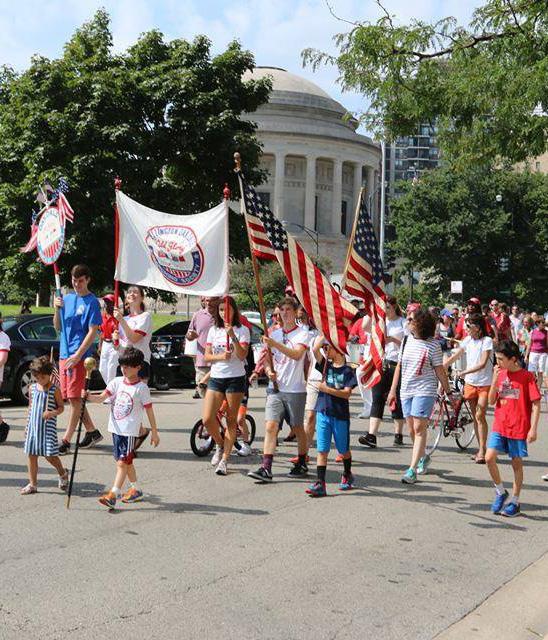

ARTS & ENTERTAINMENT
... . .
4
Compiled by Dave Hamilton & Kyra Walker
A North Side Tradition!
2023 Taste of Polonia
For four days, you can enjoy a true cultural experience that includes nonstop live music, dance performances, authentic Polish food and beer, exhibitions, local merchants, a casino, beer garden, a Kids Stage and much much more! It’s a must-do family event with attractions to keep both kids and adults happy. Hours are 5-10:30 p.m. September 1, noon-10:30 p.m. September 2-4 at Copernicus Center, 5216 W. Lawrence Ave. Daily tickets are $15, 4-day pass is $45 at topchicago.org
A Meeting of Minds!
The Baldwin-Giovanni Experience
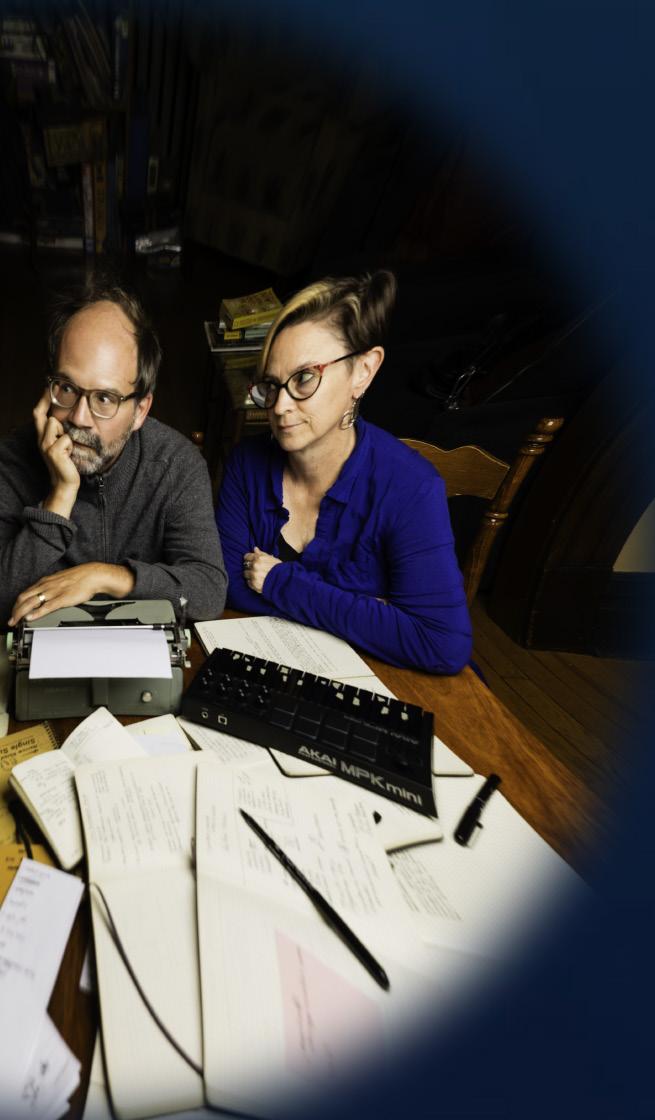
In 1971, James Baldwin and Nikki Giovanni sat down for a thought-provoking conversation about racism, manhood, writing, and teaching. Their words are as relevant today as they were then. Tim Rhoze and Bria Walker have taken this important conversation and created a dynamic theatrical experience infused with spoken word, prose, original music, choreography, and mural artwork. Playing at 7 p.m. September 2 and 3 p.m. September 3 only at the Fleetwood-Jourdain Theatre in the Noyes Cultural Arts Center, 927 Noyes St., Evanston. Tickets are $30 at fjtheatre.com
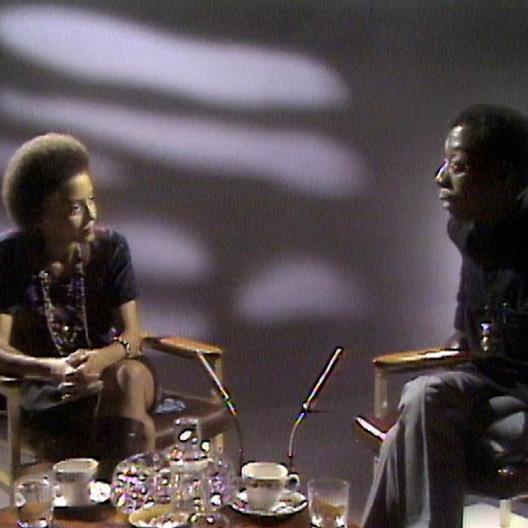
All That Jazz!
Chicago Jazz Festival

The Chicago Jazz Festival returns August 31-September 3 in Millennium Park, 201 E. Randolph St., with performances celebrating all forms of jazz. This festival is a Labor Day weekend tradition that showcases Chicago’s local talent along with international artists. FREE. Enter the festival via Michigan Avenue at Washington Street or Madison Street. More information on chicago.gov
Get Your Dance On!
Arc Music Festival
Arc Music Festival takes over Union Park, 1501 W. Randolph St., 2 - 10 p.m. September 1-3. Arc’s mission is to celebrate the world of dance music and bring it all back home to its birthplace: Chicago. Headliners include The Blessed Madonna, Boys Noize, Eric Pridz, Derrick Carter, and many more. 3-day passes start at $399, Single-day passes start at $149. Passes and tickets available as general admission, Global VIP, and the all-inclusive ICON VIP. Purchase tickets and learn more at arcmusicfestival.com

Shop 'til You Drop!
Summer Night Market | Navy Pier
Shop local businesses, enjoy free musical performances, workshops, and watch fireworks August 30 from 6-9 p.m. at the South Dock at Navy Pier, 600 E. Grand Ave. Make the evening more fun by dressing up to its theme, Chicago of the Future. Admission is FREE.



Finger-Lickin' Good!
8th Annual WingOut Chicago
At 2 - 8 p.m. September 2 and 3, WingOut Chicago is bringing a variety of mouth-watering, award-winning chicken wings and sauces to Gallagher Way, 3635 N. Clark St., Patrons can indulge in a wide variety of wings, beverages, and food, with live music, games and a festival atmosphere. Vendors will compete for the crown of "best wings" in multiple categories: Best Kick, Most Original and Best Overall.

Tickets start at $20 at wingoutchicago.com
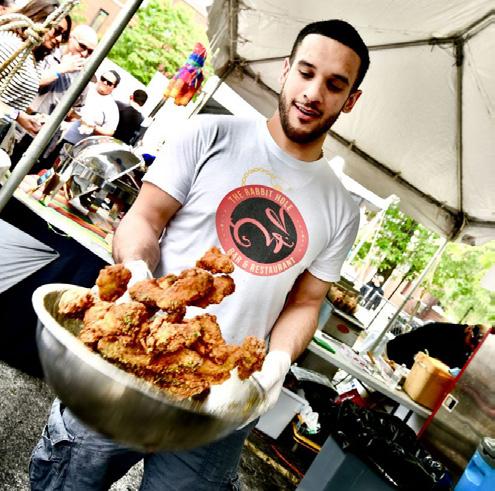
www.streetwise.org 5
Women's World Cup Disappointment
John: We are talking about the Women's World Cup. In a very disappointing fashion, Team USA crashed out of this World Cup in the round-of-16, losing a dramatic penalty shootout against Sweden in Melbourne on August 6. We want to talk about how and why it happened.
Russell: I think the reason they lost is because they really didn't do anything. They were seen as the favorite, so they didn’t play as hard. I'm gonna tell you, you have to play hard – favorite or no favorite. It was very, just very disappointing. Especially if I'm up watching it at 2 o'clock in the morning, then I gotta go to work at 4 or 5. I was trying to get some sleep in there. Another thing I hated about that is they scored no goals! How are you gonna be champions if you don't score a goal? I was very, very disappointed. But anyway, I want to say the thing that made me mad was when Megan Rapinoe missed
penalty shots. They weren't even trying, right? C’mon now. I'm not gonna keep going. I don't want to comment too much. But the bottom line is, the rest of the world is catching up to the U.S.
John: Okay, Donald, do you have an opinion on this?
Donald: Donald Trump blames Megan Rapinoe and U.S. wokeness for the loss, but I say we took a win for granted. Rapinoe is 38 and already said this would be her last World Cup. Coach Vlatko Andonovski chose 4 first-timers for the World Cup, 12 of whom had never played in a major tournament. The team was also missing four starters, including its top scorer, Mallory Swenson, out with a torn patella and team captain Becky Sauerbrunn, sidelined with a foot injury.
John: I noted the score to the United States World Cup results looked good against
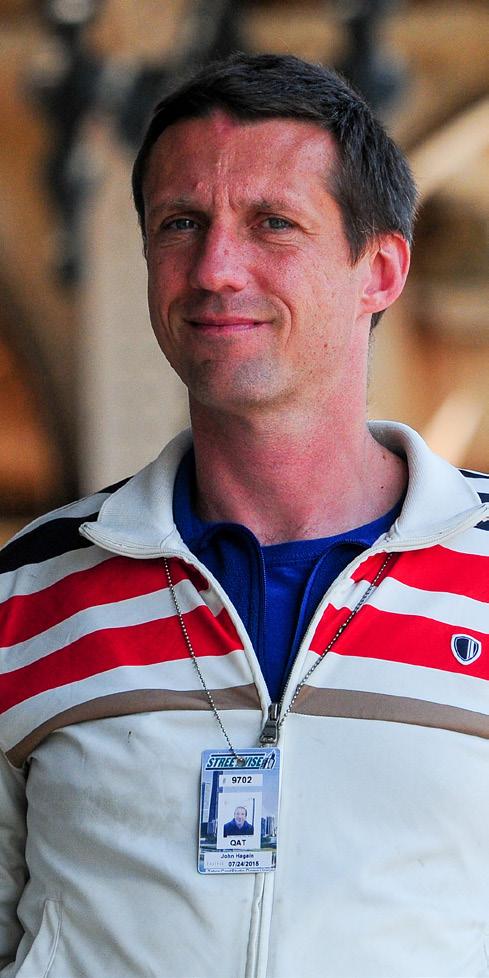
Vietnam. Of course, probably everyone looked good against Vietnam: 3-0. They tied the Netherlands. The Netherlands was playing in Spain the other day, and then they tied Portugal at 0-0. And in a game of elimination against what was supposed to be the easiest opponent, Sweden. They were tied at 0-0 and they lost in a 5-4 shootout to Sweden because Rapinoe missed the shot that could have gave the United States a chance to advance. This was the first time that they lost the World Cup since losing to Japan back in 2011.
You have to focus on the game and the coaching. They have to do a better job of developing the talent. This was not like the 1980 men's hockey team, they were lovable winners. Like the Cubs were lovable losers for many years.
Russell: Do you know parents pay lots of money for kids to play soccer? I didn't know


that. Thousands of dollars, man. That's a lot of money, man. But anyway, I was just gonna say, I am gonna give them a chance. I am still gonna be a U.S. fan because they did win before, so I got to thinking about memories that are always going to be there. But next time, try to score some goals! Thank you.
Donald: We got to remember that you must score goals in order to win games, and games and scoring means opportunities, and you have to set up and open up the shots and make sure you make all your shots. Get busy now ladies, get busy. Next time.
John: It's about attitude. And if you don't improve the attitude, you will not win.
By the way, Spain beat England August 20 to win this year's Women's World Cup.
SPORTS WISE
Rashanah Baldwin
Vendors (l-r) Russell Adams, John Hagan, and Donald Morris chat about the world of sports.
Whither US Labor Post-Pandemic? op-ed
by Victor G. Devinatz
On Labor Day 2023, COVID-19 is still with us. However, with the distribution of vaccinations, effective drugs for treatment, and hundreds of millions of people having some immunity, virus-related hospitalizations and deaths have decreased dramatically compared with 2020 and 2022.
As such, on Labor Day 2023, U.S. society and U.S. workplaces look much more like 2019, although more white-collar workers telecommute or work hybridly than before the virus. The pandemic impacted all aspects of U.S. society from 2020 to 2022, including U.S. trade unionism, but workers protected by trade unions benefited more than their nonunion counterparts. Additionally, many more strikes occurred and there was an increase in successful union organizing from 2020 to 2022.
Post-pandemic, the U.S. trade union movement must develop successful strategies to remain viable as worker representatives.
According to Economic Policy Institute research, employees covered by collective bargaining agreements, compared with nonunion workers, were more likely to be paid due to virus-related workplace shutdowns. Controlling for various employee characteristics, (such as industry, occupation, age, and more), unionized workers were 10% more likely than nonunion employees to receive pay for hours not worked due to pandemic business closures. Finally, trade unions maintained the wage premium during the pandemic, with unionized workers earning 7% more than their nonunion counterparts.
A Roosevelt Institute brief demonstrated that unionized employees were 50% less likely to lose their jobs during the pandemic, compared to all employees. Additionally, employment of unionized workers returned to pre-pandemic levels only four months after the pandemic began, by August 2020. Nonunion workers did not reach such pre-pandemic employment levels until March 2022 – two years after the pandemic struck. This substantial difference was because unionized workers benefited from labor organizations’ ability to negotiate terms and conditions of pandemic-related furloughs and layoffs. Moreover, collective bargaining maintained unionized employment levels throughout the pandemic: on average, 98.4% of the pre-pandemic rate.
Unionized workers also profited from their labor organizations taking workplace safety concerns seriously during the pandemic, but regardless of union representation, employees struck over fear of losing their lives. The Center for Economic Policy and Research reported some 1,400 strikes between March 1, 2020 and July 7, 2021. Undoubtedly, this was the largest US strike wave since 1965-1974.
All strikes in 2020 and 2021, of course, were not related to safety. With declines in both the labor force participation rate and the unemployment rate, workers had increasing leverage over their employers, which they exerted through walkouts. Such strike activity culminated in October 2021 – “Striketober” – with some 100,000 employees either walking out or planning a work stoppage.
Union organizing success also rebounded in 2022, resulting in 273,000 additional members in labor organizations, the first union membership uptick in five years. Nevertheless, union density declined to 10.1% in 2022, with private sector union density decreasing from 6.1% (in 2021) to 6.0% and public sector union density falling from 33.9% (in 2021) to 33.1% (because union growth failed to match US employment’s overall increase). Much of this organizing occurred in service establishments such as Trader Joe’s, Apple, Google, and Chipotle, for example. At Starbucks, 8,000 employees voted to unionize at 331 outlets through June 2023, although no labor contracts with Starbucks have been negotiated to date.
While enrolling more union members in 2022 is commendable, it has not sparked a tidal wave of union organizing. Also, while U.S. labor law requires an overhaul, the U.S. trade union movement will not be rescued by the Protecting the Right to Organize Act (PRO Act), which would make organizing and collective bargaining with employers substantially easier. First introduced in 2019, then in 2021 and 2023, the bill is unlikely to pass the U.S. Congress anytime soon.
One strategy for revitalizing the U.S. trade union movement is to adopt Bargaining for the Common Good on a large scale. This entails labor organizations involving themselves in wide-ranging working-class issues – climate change, affordable housing, progressive taxation – in which they speak for nonunion workers too. Such a strategy requires trade unions establish alliances with community organizations, as the Chicago Teachers Union did in its successful 2012 community-labor alliance to defend Chicago’s public schools.
Given that trade unions represent a declining fraction of the labor force, it is necessary for labor organizations to fight for all workers, regardless of union status. Future successes, as in Chicago in 2012, will help in recruiting nonunion employees, while giving trade unions a fighting chance in remaining viable for struggles in the years ahead.
Dr. Victor G. Devinatz is Distinguished Professor of Management, specializing in labor relations, and was the Hobart and Marian Gardner Hinderliter Endowed Professor (2014-2015) at Illinois State University. He can be contacted at vgdevin@ilstu.edu
OP-ED 7
VOICE OF THE STREETS
Less Sleep, Less Exercise and less Relaxation:
 by Todd Jones, Benhamin Cowan, and Jeff Swigert
by Todd Jones, Benhamin Cowan, and Jeff Swigert
The big idea
Moms of school-age children get significantly less sleep during the school year than during the summer.
We are economists who specialize in education and health research. We combined extensive data on school district schedules with information derived from the American Time Use Survey to explore the ways families use their time differently depending on whether school is in session or out for summer.
We observed mothers on average tend to sleep 25 minutes less, have 28 minutes less free time and allocate seven minutes less for exercise on weekdays during the school year than during the summer. For comparison, fathers reduce sleep by 11 minutes during the school year relative to the summer, have 21 minutes less free time and five fewer exercise minutes.
Conversely, mothers spend about half an hour more per day during the school year taking care of others, including kids, and five additional minutes on travel – which often involves driving their kids to and from school.
Interestingly, even though both mothers and fathers spend more time physically present with children in their household during summer months, both spend more time actively engaged with the children – such as helping with homework or reading together – during the school year. However, the effect is almost three times greater for women than it is for men: Moms spend an extra 34 minutes per day during the school year actively engaged with the children versus an extra 12 minutes for dads.
Our study also observed teenagers ages 15-17, as they are the only children included in the time use survey.
During the school year, teenagers sleep about one hour and 20 minutes – or 13% – less than they do during the summer, and they have over two hours – or 33% – less free time each day. This reduction in free time includes nearly an hour and a half less time spent each day on television, games – including video games – and computer use.
Why it matters
Prior research has shown there is a gender gap in mental health, with women faring worse than men on measures such as anxiety and depression. Women are also four times as likely as men to be diagnosed with Seasonal Affective Disorder (SAD), a type of depression that typically occurs in fall and winter (see story page 11).
Our results suggest the possibility that these issues are exacerbated by the greater demands placed on mothers during the school year.
Our findings support arguments for later school start times so that teens can get more sleep (see story page 9). The American Academy of Pediatrics has recommended middle and high schools start no earlier than 8:30 a.m., so that adolescents can get sufficient sleep to support mental health and academic achievement. However, the average start time for U.S. high schools is 8 a.m.
Our results also suggest that when school is out, teenagers may be especially susceptible to media overconsumption. Teens themselves say they spend too much time on screens.
COVER STORY
8
Moms get about 25 minutes less sleep each weeknight when their kids’ school is in session (Jose Luis Pelaez Inc/ DigitalVision Collection photo).
How Much Busier moms are During the School Year
Sleepmore in Seattle:
Later school start times are associated with more sleep and better performance in high school students
Most teenagers are chronically sleep deprived. The results of a Seattle, WA study suggest that delaying high school start times could decrease the learning gap between low- and high-socioeconomic groups.
Adolescents typically prefer to stay active until late-evening and to wake up late-morning. This timing is not only because of a change in social life and the use of electronic devices that keep teenagers awake. During puberty, the adolescent circadian system naturally delays the onset of sleep.
Most adolescents get less than the recommended daily 8-10 hours of sleep for their age. The American Academy of Pediatrics, in 2014, proposed delaying school start times to increase sleep.
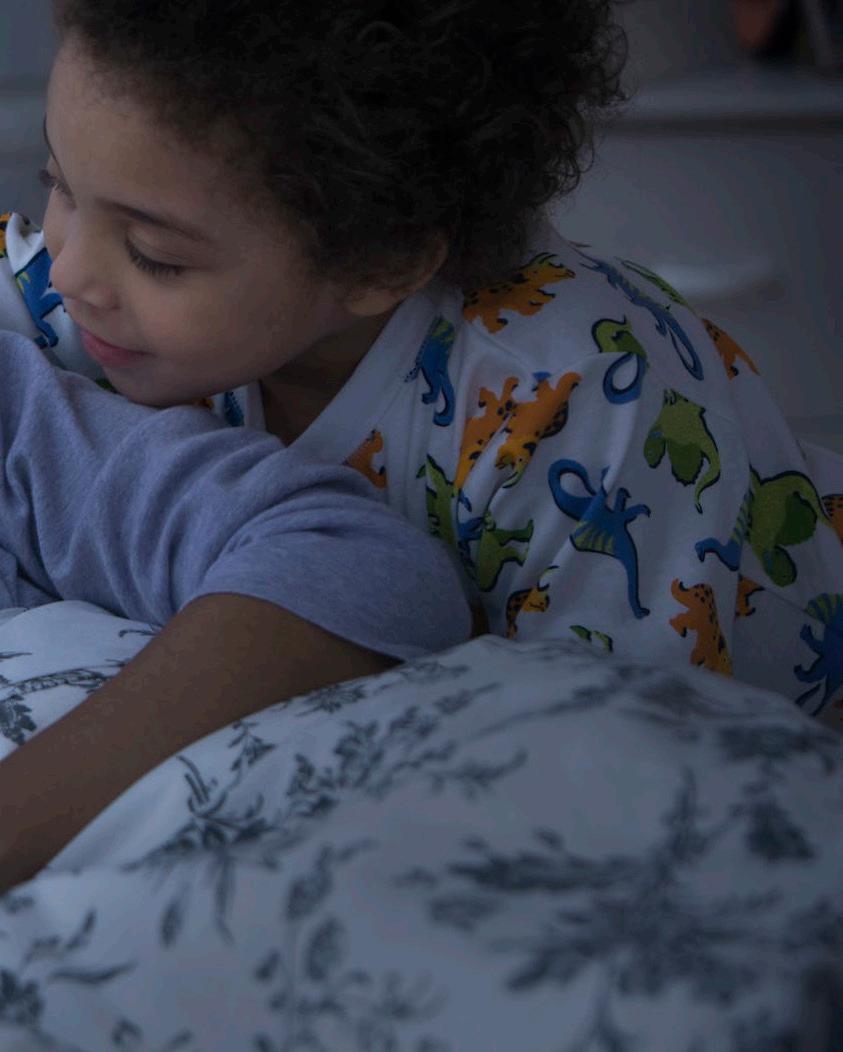
What we still don’t know
We do not yet know how these changes in schedules affect teen mental health. While some measures of teen mental health improve during summer months, we found that teenagers spend the lion’s share of their extra summer free time in front of screens, and studies have linked excessive screen time to higher levels of depression and poorer mental health.
Todd Jones is Assistant Professor of Economics at Mississippi State University. Benjamin Cowan is Associate Professor of Economics at Washington State University. Jeff Swigert is Assistant Professor of Economics at Southern Utah University. Courtesy of The Conversation.
The Seattle School District did just that for the 2016-17 school year. Secondary schools went from a 7:50 a.m. start to 8:45 a.m. Sleep-wake cycles were measured using wrist activity devices on sophomores at two public high schools. The students also kept a sleep diary.
Pre- and post-research showed an increase in the daily median sleep duration of 34 minutes, associated with a 4.5% increase in the median grades of the students and an improvement in attendance.
Whereas Roosevelt High School (RHS) showed no difference between years, students in Franklin High School (FHS) had significantly fewer tardies and absentees in 2017 than in 2016. Notably, FHS has many more economically disadvantaged students (88%) and ethnic minorities (68%) than RHS (31 and 7%, respectively).
The study showed that better realignment of sleep-timing to teens’ circadian systems meant reduced sleepiness and better academic performance.
Lengthening the median daily sleep period reverses a century-long trend in sleep loss. It returns sleep to the era before teens had access to brightly lit environments and light-emitting screens.
Read the complete study at www.science.org/doi/10.1126/sciadv. aau6200
www.streetwise.org 9
How parents can help with back-to-school anxiety
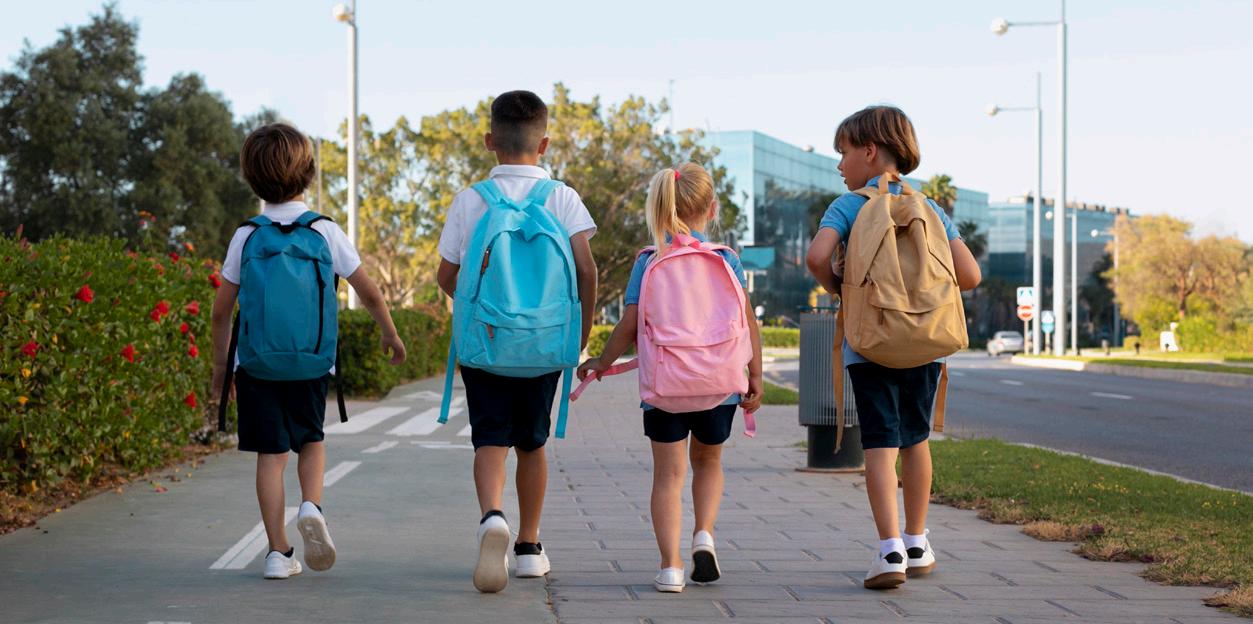 by Elizabeth Englander. Katharine Covino-Poutasse contributing.
by Elizabeth Englander. Katharine Covino-Poutasse contributing.
Anxiety among children is common, to varying degrees.
Pre-pandemic, researchers noted that up to 7% of children had a diagnosable anxiety disorder that disrupted their everyday functioning. In addition, 20% had a tendency to feel anxious that didn’t rise to the level of a clinical disorder. And all children feel anxious at some time or another.
During and after the pandemic, most researchers found that anxiety in children increased. The reason may have been lockdowns that isolated children from their peers, and interruptions to their routines.
As a researcher of children’s mental health for decades, I know that predictability helps prevent anxiety. Predictability means the same pattern: sleep at night, up in the morning, cornflakes for breakfast, off to school, activities in the afternoon, dinner with the family. In Louise Fitzhugh’s children’s novel “Harriet the Spy,” Harriet’s mother can’t believe that her daughter always takes a tomato sandwich to school. Always. Harriet has no interest in variety. She’s perfectly happy with the same sandwich, year after year.
Anxiety will crop up for many children again this fall, and it can be intertwined with excitement and shyness. Here are steps parents can take to reduce their kids’ back-to-school anxiety and encourage a better start to the fall term.
1. Look for general symptoms of anxiety
Ask your kids how they’re feeling about going back to school. Keep an eye out for headaches, stomachaches, sleeping troubles, persistent “what if” questions, crankiness, excessive concern about very distant events, problems focusing on schoolwork and concerns that aren’t alleviated by logical explanations. An example might be your children worrying that they won’t have friends in school, even though they do have friends from their class last year; or concerns that while they’re at school, something extremely unlikely will happen, such as the house being hit by lightning. What’s tricky, of course, is that any of these behaviors can be an indication of many different problems, so probe further. Talking to your kids about their thoughts may help you determine if they’re feeling anxious.
2. Encourage activities that reduce anxiety
Playing outside, playing with friends or even just “hanging out” can be powerful ways to reduce negative feelings. Outdoors, people often feel more relaxed. Playing in an unstructured way – that is, without someone else telling them what or how to play – allows kids to work through their feelings and reduce anxiety.
3. Limit kids’ screen time
Researchers have found that, post-pandemic, more children are using different types of digital devices, along with more social media apps. Significant evidence finding a link between excessive digital device use and anxiety suggests that these increases in device use may add to increased anxiety in children.
4. Focus on family activities
The emotional connection that children have with their families is their psychological anchor during difficult times. During increased stress and uncertainty, spending time with family can be an antidote. Take a walk or a hike together, eat dinner together, or play board games.
5. Embrace distraction
Distraction isn’t a cure for anxiety, but it can diminish its intensity and help sufferers think more clearly about the source of their worries. When children are feeling very anxious, it’s fine to talk to them about how watching TV or reading a funny book can help them feel calmer.
6. Get professional help when needed
If your child’s anxiety is interfering with sleep, eating, socializing or school attendance, and it persists beyond a few days, tell your pediatrician or family doctor. Medical professionals who work with children have seen anxiety skyrocket among kids, and they know how to get your child the necessary help. As with any back-to-school season, you may find yourself shopping for binders and backpacks. However, children and their anxiety may also need your attention. Practicing simple prevention and intervention, when necessary, can get your kids off to a great school year.
Elizabeth Englander is Professor of Psychology at Bridgewater State University. Katharine Covino-Poutasse is Associate Professor of English Studies at Fitchburg State University. Courtesy of The Conversation.
10
Seasonal Affective Disorder: six questions answered
The change in seasons can bring on a type of depression called seasonal affective disorder (SAD). According to the National Institute of Mental Health, SAD is diagnosed four times more often in women than men. Dr. Yael Nillni is a clinical psychologist and assistant professor at the Boston University School of Medicine and the National Center for PTSD, Women’s Health Sciences Division. She talks about when to see a doctor, treatment options, and more in a blog originally published on womenshealth.gov.
How would you describe seasonal affective disorder (SAD)?
SAD is essentially the same as major depression, but it follows a seasonal pattern. It most commonly occurs during the fall and winter and goes away in the spring or summer. However, some people have different seasonal patterns, so SAD can happen during the summer, too. It’s just more common for people to experience it in the fall and winter.
What are the common symptoms of SAD?
Since SAD is essentially depression with a seasonal pattern, the symptoms are the same. During the winter months, many people experience a change in how they feel, such as a change in energy levels or eating habits. But these changes don’t significantly impact their lives the way SAD does. Someone experiencing SAD will usually start to hibernate — I think this is the best way to describe it. They withdraw and stop engaging in their lives by not doing things they typically enjoy and not seeing friends and family. Other classic symptoms of SAD are sleeping more, having low energy, and eating more.
When should women see their doctors?
Ask yourself if your symptoms are getting in the way of your day-to-day life. It’s common to have changes in mood or behavior during the winter, but if your symptoms are affecting your relationships or your ability to get things done, you should see a doctor.
If you’re having thoughts of hurting yourself, get help right away. If you’re in immediate danger, call 911.
How can women manage SAD?
Light therapy includes sitting in front of a light box every morning to increase exposure to light. Typically, your doctor, nurse, or a mental health professional prescribes the light box. They tell you when you should sit in front of it and for how long. Then you’ll check in with them to see
how it’s working and tweak the approach as necessary. Most people begin using the light box when their symptoms start, (in the fall), and use it daily until symptoms go away, in the spring or summer.
There’s also cognitive behavioral therapy specific to SAD, which is a type of talk therapy that you can do with a mental health professional. Cognitive behavioral therapy targets thoughts and behaviors that may be getting in the way of feeling better. The cognitive part focuses on examining and challenging negative thoughts, and the behavioral part focuses on scheduling positive and pleasant activities. People often fall into a negative cycle. They feel down, so they disengage and do less, which in turn makes them feel even more down and depressed. Challenging negative thoughts and scheduling activities you enjoy can help you kick out of this cycle and influence your mood in a positive way.
Your doctor, nurse, or mental health professional may also prescribe medication to help you manage SAD symptoms.
Are there other daily habits you recommend that might help women cope with SAD?
If I could give one recommendation, it’s to find activities you enjoy. Anything! Just choose something you can do throughout the year so you can continue to stay active in your life and not disengage when the seasons change. The key is to stay engaged by doing things you enjoy.
Additionally, know your warning signs. When you see and feel that you’re starting to pull back, that’s the time to act, whether that means using your light box, scheduling activities you like to do, or making an appointment with a mental health professional.
What’s one thing you wish all women knew about SAD?
Help is available! Effective treatments for SAD have been well-studied. You don’t have to suffer every winter. A lot of the people I see have been suffering with SAD for years, but they do get better with treatment. SAD affects a lot of people, and there’s nothing wrong with getting help. As mental health professionals, we have a set of skills that we can teach you to help you feel better.
Read more at www.womenshealth.gov/blog/ seasonal-affective-disorder-spotlight
www.streetwise.org 11
Greek Orthodox Church’s 100th Anniversary Showcases Nativity Icon
by Stella Kapetan
The community of Chicago’s St. Basil Greek Orthodox Church, just south of Ashland Avenue and Polk Street, marks the 100th anniversary of its founding September 17. The first worshippers were immigrants, many from the island of Crete, most of whom established grocery stores and produce pushcart businesses. The building is in the Greek Revival style and was erected as Anshe Sholom Synagogue in 1910 by Jews who had settled nearby. By the time the Greeks bought the building, many Jewish families had moved to the Lawndale neighborhood on the West Side where they built a new temple.

As is traditional in Orthodox churches, icons – painted images of Christ, the Virgin Mary, saints and angels – adorn the walls and other spaces throughout. Icons are an important part of worship in the Orthodox faith, a religion that traces its beginning to the Twelve Apostles. “Icons bring us into close contact with the divine, and we connect with them through the icons,” the Rev. Athanasios Minetos, parish priest said. “We are brought into heavenly realm through the beauty of the icons.”
FROM THE STREETS
Minetos recently interpreted the traditional Nativity icon that is on the north wall of the sanctuary and venerated yearround. It is in the style of the Nativity icon first painted in the mid-15th century. Artist Tom Clark created this icon in the early 1990s following strict guidelines as to dimension, shape and scale of images. He reproduced it after a major building fire destroyed the original in 2013.
The setting is a cave, where Orthodox tradition holds Christ was born. “At the center is the Virgin Mary lying next to Christ and pointing to Him,” Minetos said. “Anytime we have an icon of the Virgin Mary, she is always pointing to Christ, because He is the Son of God. He is the one we are worshiping, not her,” Minetos said. She looks relaxed because Orthodox tradition also teaches that she suffered no pain during Christ’s birth.
Christ’s swaddling foreshadows his post-Crucifixion burial shroud, while he is kept warm by the animals’ breaths. The three wise men on the left follow the star that shines down on him. “The star is blue because the light was so bright that it was brighter than white,” Minetos said.
Angels proclaim glory to God in the highest and bring good tidings to the world, including the shepherd playing his reed pipe on the right. He represents Christ’s first visitors who were nearby tending their flock. The angels’ covered hands “represent they are humbly serving God.” Minetos said. “They don’t feel worthy to touch the Son of God with bare hands.”
The Orthodox belief that Christ was born both fully divine and fully human is shown in the lower right. Midwives bathe him “yet he looks like a little man to show he is more than just a child. He is the Son of God, and he knows he is the creator of the universe,” Minetos said.
The tree next to them symbolizes Christ’s fulfillment of the Old Testament prophecy that the Messiah would grow from the family tree of Jesse, King David’s father. Christ is descended from the line of David, through his mother and Joseph.
Joseph, in the lower left, looks perplexed as the devil disguised as an elderly man tempts him to reject Christ and the Virgin Mary. “The devil is saying, ‘This is someone else’s
12
child. Don’t’ believe what she is saying,’” Minetos said. Joseph’s halo shows he resists the devil.
This use of symbolism in the scenes is a widely used technique in Orthodox iconography, dating back to the first icons painted in the first century AD. “We are less interested in how things looked and more interested in what they mean,” Minetos said. “We don’t know how it actually looked.”
Minetos pointed out that all the faces are peaceful, and the icon’s main takeaway is the “peace and quietness of the event. Christ’s birth was a quiet event that is supposed to give us peace,” he said.

Chicago Coalition for the homeless announces six scholarship recipients
Six first-year college students will attend universities in Illinois and Washington, D.C. on $4,000 scholarships awarded by the Chicago Coalition for the Homeless (CCH). Also continuing on CCH scholarships at colleges and universities in California, Illinois, Georgia, Michigan, Wisconsin and Washington, D.C. are six sophomores, seven juniors and five seniors.
The new scholarship winners are:
Charles Ibrahim, a first-generation college student who moved to the U.S. from Nigeria when he was 8. He plans to major in mechanical engineering at the University of Illinois-Chicago.
At Amundsen High School, Charles was a peer advisor, an orchestra mentor, and a member of an engineering club where he learned about fixing appliances and building machines. Charles was named most improved player on his varsity football team and graduated from his high school’s International Baccalaureate (IB) program.
Kary Hernandez, who has been accepted into Loyola University’s five-year program for undergraduate and graduate degrees in social work. At West Chicago Community High School, she wrote for the yearbook and school newspaper, The Wildcat Chronicle, and was an executive board member of a women’s leadership club and a member of the National Honor Society.
Anniversary
www.streetwise.org 13
Left: Interior of St. Basil Greek Orthodox Church (St. Basil Greek Orthodox Church photo). Above: Photo by Stella Kapetan.
“I am fortunate to have supportive teachers, social workers and counselors who do not make me feel bad for not having access to necessities,” Kary wrote in her application. “I want to be that person for others so they can feel cherished…What truly makes me joyful is to break the cycle of poverty, abuse, neglect, and much more.”
Micheal Brown has dreamed of becoming a full-time musician since he was 6. He plans to major in music and business at Howard University, with the goal of becoming a successful musician who uses his influence to address prison reform, poverty and racial inequality. At George Westinghouse College Prep, Micheal played first chair trumpet in the honors band, took piano lessons, and participated in a poetry slam. He studied music business and audio production through summer classes. Micheal also played varsity football, volunteered at his church, and worked up to 30 hours per week in various service industry roles.
Sabene Uwazie will attend Howard University and major in psychology. Her academic interests include physics, theater, psychology, African American studies, and gender studies. “Even though these interests are in very different subjects, they all have an overlapping theme: to help and heal Black people as much as possible,” she wrote.
An Evanston Township High School graduate, Sabene was an actor and assistant director in several school plays. She also participated in color guard, worked at Starbucks, and was a member of the Black Student Union.

Serenity Rainey will major in psychology at Illinois State University, and plans to pursue a doctorate.
“I want to be a child psychologist because a lot of kids’ mental health is overlooked,” Serenity wrote in her application. “I want to be the person they can come and talk to. I want to help them understand that their feelings are valid,
and they don’t have to feel like they aren’t being heard. I want to be the person that I needed when I was their age.”
Serenity graduated from Daniel Hale Williams Prep School of Medicine. She was a member of the National Honor Society and the South Shore Drill Team. She worked service jobs and completed a Certified Nursing Assistant (CNA) internship with Phalanx Family Services.
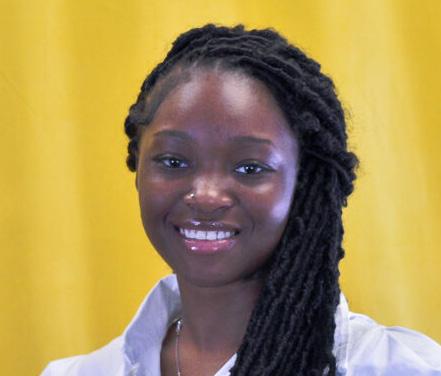
Tai Ramirez graduated from Walter Payton College Prep, where they created and directed the Latin Music Ensemble, a performance group for Latinx musicians. As an executive board member for the Latin American Coalition, they also coordinated the school’s first Latinx Heritage Month Arts Showcase. Outside of school, Tai worked as a teaching assistant at the Segundo Ruiz Belvis Cultural Center, focused on Afro-Caribbean/Afro Puerto Rican music and dance. In 2022, Tai received special recognition during Latinx Heritage Month by the Mayor of Chicago for their artistic contributions.
An aspiring art teacher, Tai plans to major in art education at the University of Illinois Chicago.
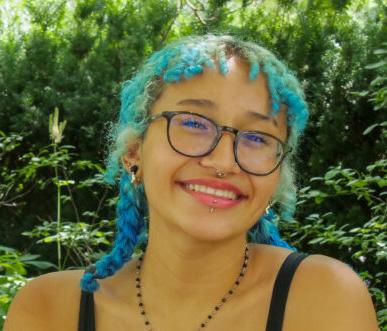
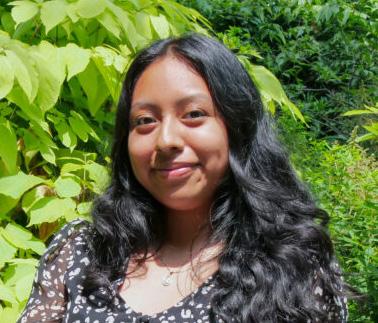
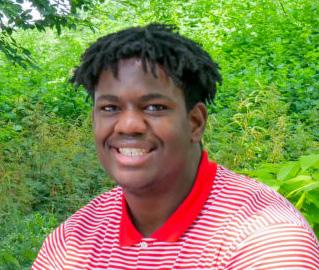

“I want to create accepting and creative spaces in schools for Chicago’s youth to explore themselves and their identities through art and creative expression,” Tai wrote in their application. “I want to create healthy learning environments that inspire the upcoming generations of Chicago.”
Launched in 2004, CCH’s scholarship program provides up to five years of financial support as students work towards a college degree. Four scholarship program alumni now in graduate school will receive $500 stipends for books or other academic materials. These students are pursuing a master’s in education, law school, and PhDs in sociology and environmental engineering. -from prepared materials

14
The Winners of the CCH scholarship program pose together. clockwise from left: Charles Ibrahim, Kary Hernandez, Tai Ramirez, Serenity Rainey, Sabene Uwazie, and Micheal Brown (photos provided by Chicago Coalition for the Homeless).
To solve the Sudoku puzzle, each row, column and box must contain the


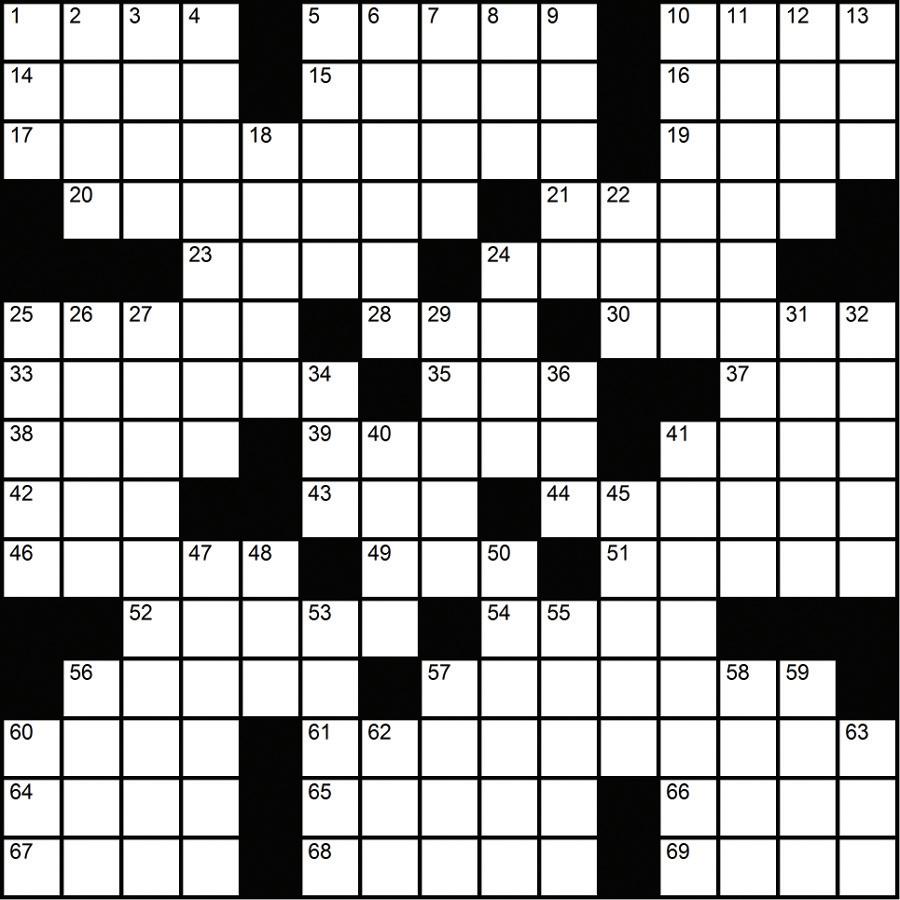

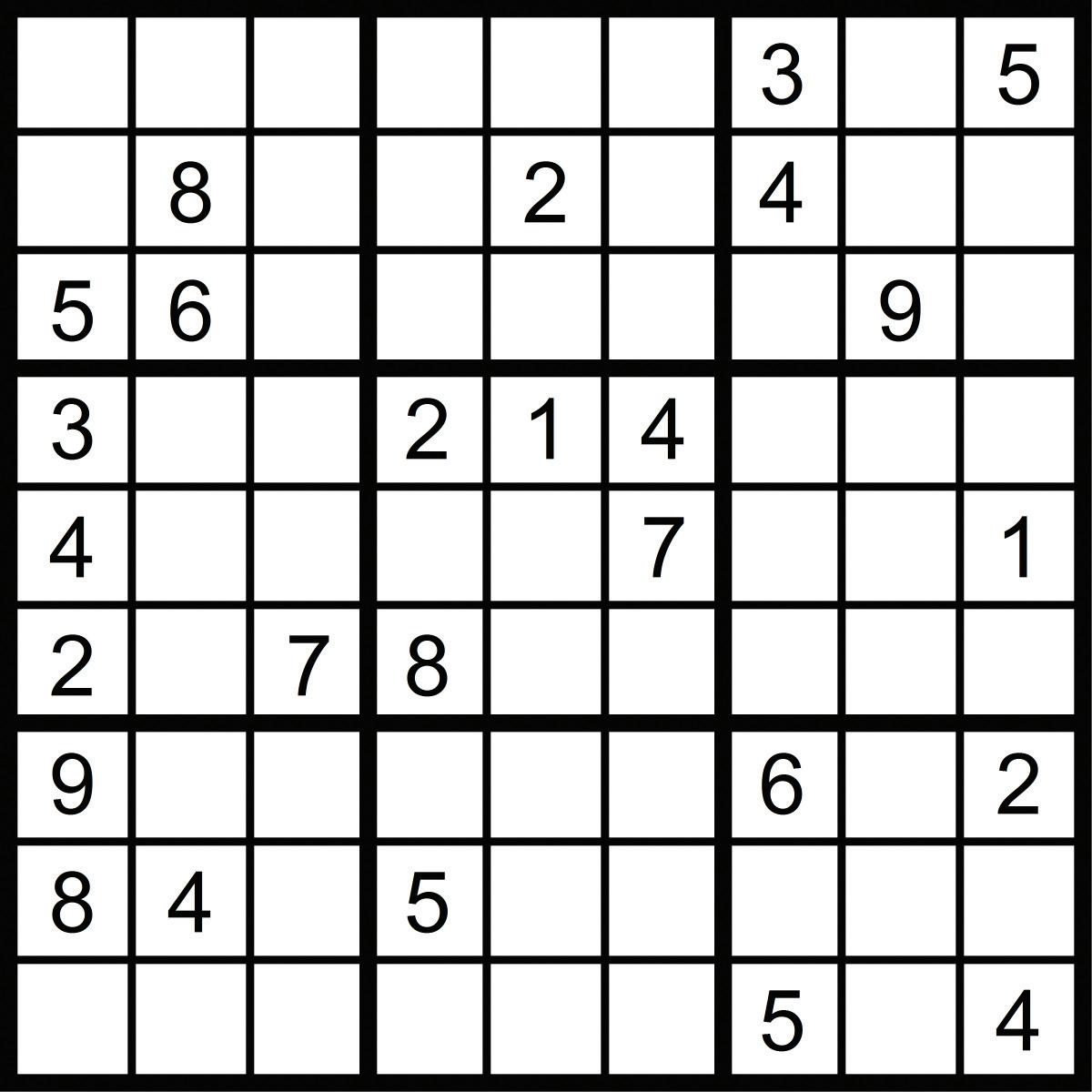

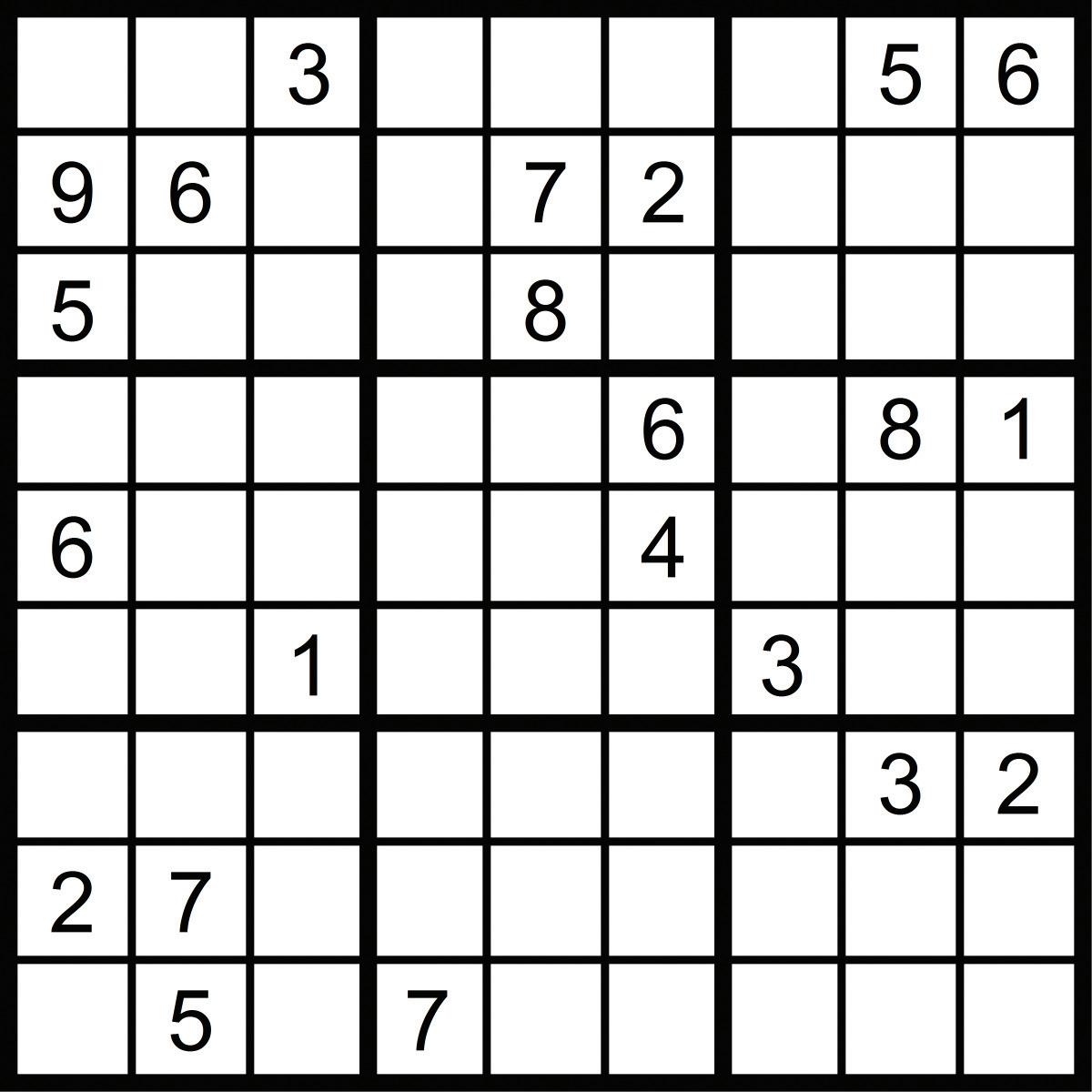
Last week's Answers
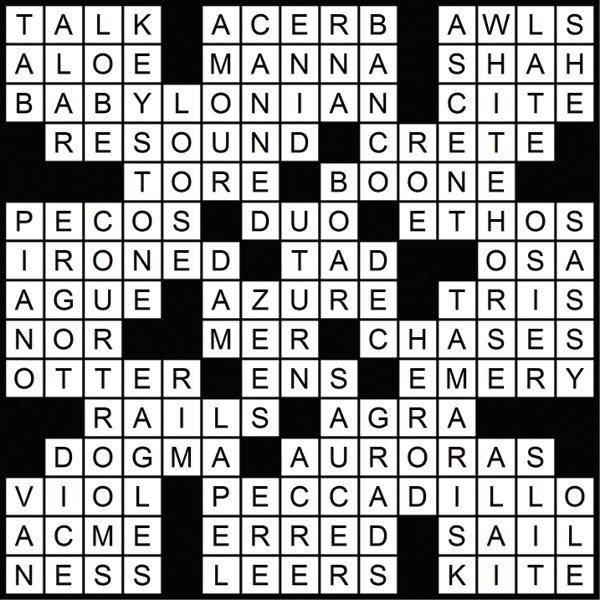
How StreetWise Works
StreetWise exists to elevate marginalized voices and provide opportunities for individuals to earn an income and gain employment. Anyone who wants to work has the opportunity to move themselves out of crisis.

StreetWise provides “a hand up, not a handout.”
All vendors go through an orientation focusing on their rights and responsibilities as a StreetWise Magazine Vendor. Authorized vendors have badges with their name, picture and current year.


Vendors purchase the magazine for $1.15 and sell it for $3 plus tips. The vendor keeps all of their earnings.
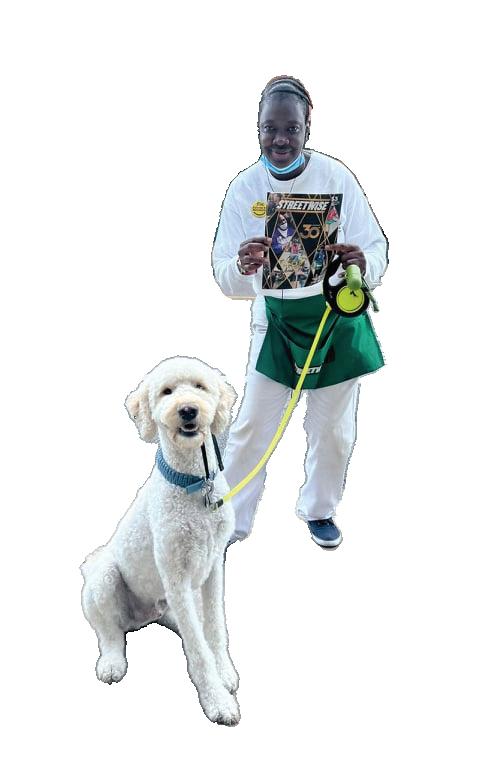
When you buy the magazine, take the magazine, and read the magazine, you are supporting our microentrepreneurs earning an income with dignity.
New vendor orientation is every Tuesday and Thursday at 10:00 a.m. at 2009 S. State St. Find your nearest vendor at www.streetwise.org
Copyright ©2023 PuzzleJunction.com Streetwise Sudoku PuzzleJunction.com Sudoku Solution
Copyright ©2023 PuzzleJunction.com Sudoku Solution 1 to 9. ©2023 PuzzleJunction.com Solution 32 Flippant 34 Water holder 36 Holiday mo. 40 Zorro’s marks 41 Salt-loving evergreen 45 Early Judean king 47 Birds of prey 48 Canyon feature 50 Cup holder 53 Place for a pin 55 Alumni, briefly 56 Backgammon equipment 57 Farm measure 58 Jai ___ 59 Narrow opening 60 Moving option 62 Bard’s “before” 63 Corrida cry 60 Six-stringed instrument 61 Indiscretion 64 Culmination 65 Goofed 66 Spinnaker, e.g. 67 Capone nemesis 68 Ogles 69 Toy with a tail Down 1 Keyboard key 2 Wing-shaped 3 Brain section 4 Anchor; backbone 5 French romance 6 Fired 7 “National Velvet” author Bagnold 8 Genetic initials 9 Financial institution, in Spain 10 Rapid upward movement 11 Yukon Territory capital 12 Like the White Rabbit 13 1965 Ursula Andress film 18 On the lam 22 Caviar 24 Wild hog 25 Nero’s instrument 26 Plant disease 27 Attorneys’ venues 29 Common road sign, No ___ 31 Basket material
Streetwise 8/13/23 Crossword PuzzleJunction.com ©2023 PuzzleJunction.com 38 Bad habit, so to speak 40 In addition 41 Biblical king 43 White rat, e.g. 44 Like Playboy cartoons 46 John Lennon hit 47 Goatee’s locale 48 Bank of Paris 49 From a distance 50 Queen’s residence 51 Nibble away 52 ___ in a blue moon 53 Bengal and Biscay, e.g. Across 1 Bring in the sheaves 5 Uncovers 10 Talk effusively 14 A celebrity may have one 15 Yemeni’s neighbor 16 Northern capital 17 Savannas 19 Saltimbocca ingredient 20 Kind of story 21 Dry run 22 Chock 23 Time pieces 24 Rude person 26 River in England and Wales 29 Summer quencher 33 Certain exams 34 Tartan 35 “I’m impressed!” 36 Cleopatra backdrop 37 Gregorian follower 38 Mouselike animal 39 Curling surface 40 School affairs 41 Backpacker 42 California island resort 44 Time out 45 Garage job 46 Fencing material 54 Old 45 player 55 Diva 58 Dr. Pavlov 59 Competitor 60 Off-color 61 Galba’s predecessor 62 Correct, as text 63 Lady bighorns Down 1 Teases 2 Continental currency 3 Speedy steed 4 ___ de deux 5 Second wife of Henry VIII 9 “___ boom bah” 10 Rule 11 Played for a sap 12 Smelting waste 13 Duffer’s target 18 Asterope and Pollux, e.g. 22 Timber 23 Expunge 24 Legumes 25 Skip over 26 Kind of boom 27 Susan Lucci’s Emmy role 28 Manservant 29 Guanaco’s cousin 30 Came to 31 Dispenses, with Crossword ©PuzzleJunction.com
Buy the Magazine, Take the Magazine
-or-





























 by Todd Jones, Benhamin Cowan, and Jeff Swigert
by Todd Jones, Benhamin Cowan, and Jeff Swigert

 by Elizabeth Englander. Katharine Covino-Poutasse contributing.
by Elizabeth Englander. Katharine Covino-Poutasse contributing.





















